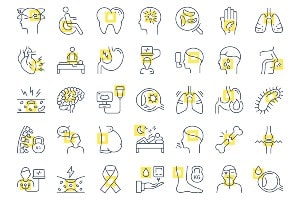About Spinal Headaches

Learn about the disease, illness and/or condition Spinal Headaches including: symptoms, causes, treatments, contraindications and conditions at ClusterMed.info.
Spinal Headaches

| Spinal Headaches |
|---|
Spinal Headaches InformationIntroduction to Spinal HeadachesA spinal headache can occur as a result of a procedure such as a spinal tap (lumbar puncture) or epidural block (such as that performed during a woman's labor and delivery). In these procedures, a needle is placed within the fluid-filled space surrounding the spinal cord. This creates a passage for the spinal fluid to leak out, changing the fluid pressure around the brain and spinal cord. If enough of the fluid leaks out, a spinal headache may develop.Because the design of spinal needles has been improved, spinal headaches after a spinal tap or administration of spinal anesthesia are rare. When epidural anesthetics are placed with a larger needle than that used for spinal anesthetics, however, the likelihood of headache is higher if the epidural needle should inadvertently pass through the dura matter (covering of the spinal cord).A spinal headache may occur up to five days after the procedure is performed. Such a headache may be prevented with bed rest after a procedure. How Are Spinal Headaches Treated?The first course of treatment for spinal headaches involves supplying adequate hydration to try to increase cerebral spinal fluid (CSF) pressure. Sometimes intravenous fluids (fluids administered into the veins) are given; other times the person is advised to drink a beverage high in caffeine. Strict bed rest for 24-48 hours is also recommended.In addition, if a person develops a spinal headache following a procedure, the anesthesiologist can create a blood patch with the person's blood to seal the leak. To administer a blood patch, the anesthesiologist inserts a needle into the same space as, or right next to, the area in which the anesthetic was injected. The doctor then takes a small amount of blood from the patient and injects it into the epidural space. The blood clots and seals the hole that caused the leak. What Are the Symptoms of a Spinal Headache?The spinal headache often is described as "a headache like no other." Spinal headaches are much more severe when the person is in an upright position; they improve when the person lies down. |
More Diseases
A | B | C | D | E | F | G | H | I | J | K | L | M | N | O | P | Q | R | S | T | U | V | W | X | Y | Z
Diseases & Illnesses Definitions Of The Day
- Noncancerous Colloid Thyroid Nodule (Thyroid Nodules) ‐ How are thyroid nodules diagnosed?, Introduction to thyroid nodules …
- Skin, Laser Resurfacing (Laser Resurfacing) ‐ CO2 Laser Resurfacing, Complications of Laser Skin Resurfacing …
- Malignant Fibrous Histiocytoma (Bone Cancer Overview) ‐ Are there any treatments or medications that relieve bone cancer pain? …
- Double Vision ‐ Is it possible to prevent double vision?, What are the symptoms and signs of double vision? …
- Ageusia (Taste Disorders) ‐ Are taste disorders serious?, Can taste disorders be treated? …
- Autism Screening and Diagnosis ‐
- Alpha-fetoprotein Blood Test ‐ In which situations are high blood (serum) levels of AFP used as a tumor marker? …
- Polymyalgia Rheumatica ‐ How do health care professionals make a diagnosis of polymyalgia rheumatica? …
- Stump Appendicitis (Appendicitis) ‐ Appendicitis definition and facts, Are there long-term consequences of appendectomy? …
- Gonorrhea (Gonorrhea In Women) ‐ Gonorrhea facts, How is gonorrhea diagnosed?, What are sexually transmitted diseases (STDs)? …